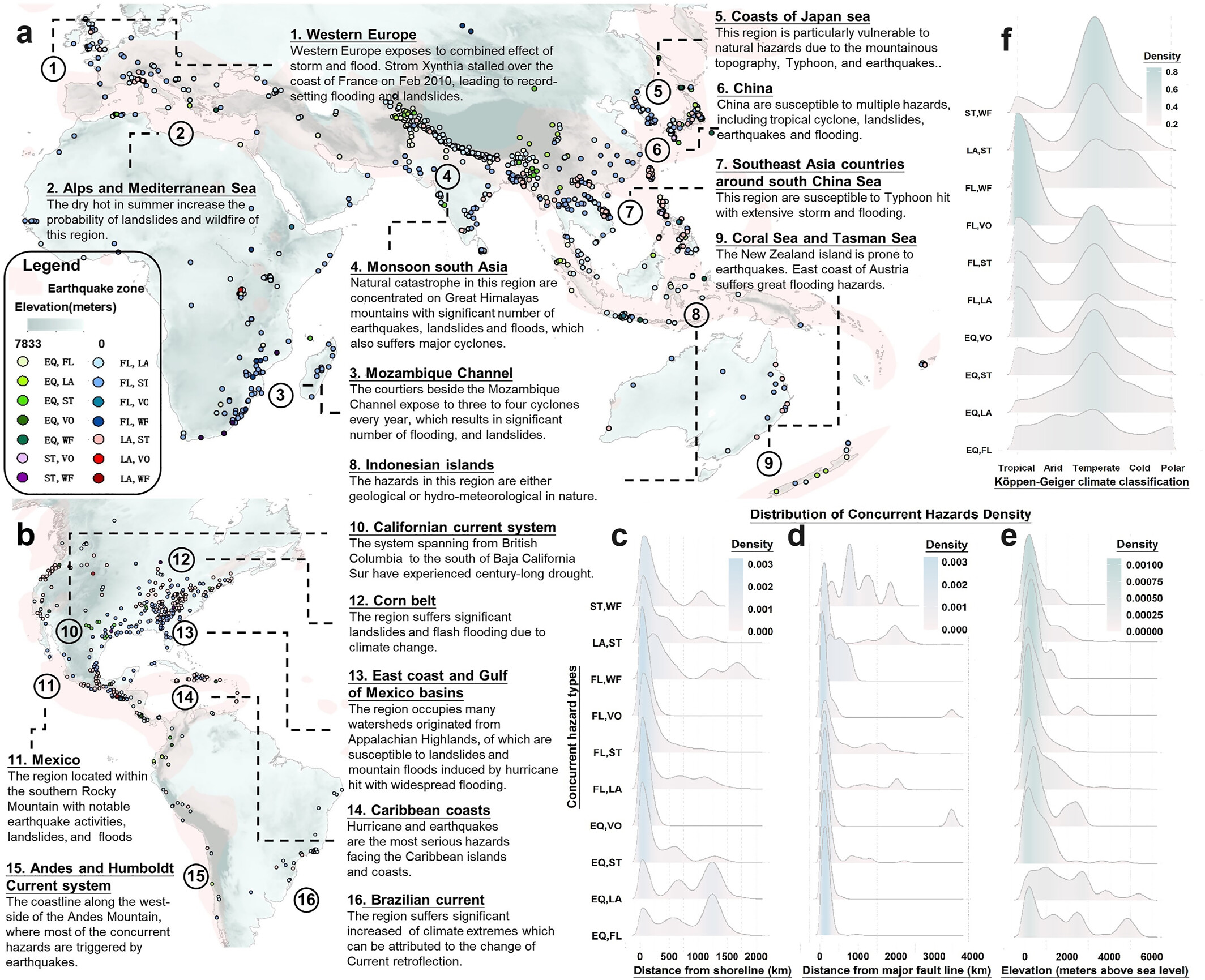The group has made research progress in the field of global composite disaster identification and risk assessment:

Complex disasters are defined as natural hazards that overlap in space and time. It is well known that spatial and temporal composite disasters can cause devastating losses on a scale far greater than those caused by any isolated disaster. However, scientific evidence of the potential risk of compound extreme events, as predicted by current hazard models, is still very limited. Little is known about the evolution of globally distributed composite hazards, whose superimposed consequences are caused by natural and anthropogenic forces in a changing environment. In order to fill this significant knowledge gap, the team's Dr Yi-Lei Hsu is publishing the results of her research entitled ‘Increased Significance of Global Concurrent Hazards From 1981 to 2020’ in September 2024 in Earth's Future.
The team developed the world's first long time-series, high-quality composite hazard dataset. Based on a standard system for identifying composite hazards, the team identified 1,614 composite hazards for the period from 1981 to 2020 from 121,214 records of different types of hazards around the globe, covering 14 composite types of six major hazards, namely earthquakes, storms, landslides, volcanoes, wildfires and floods, and identified 16 hotspot areas suffering from composite hazards for the first time on a global scale. It is the first time that 16 hotspots of compound hazards have been identified globally. The dataset clearly reflects the temporal and spatial information of global composite hazards and provides a new source of data for assessing the relative impacts of composite versus isolated risks.

The study proposes a novel composite hazard event extraction (ConEx) method, which automatically identifies and obtains information about composite hazard events from a single hazard database. Before composite disaster event extraction, the disaster event descriptions from multi-source databases are subjected to text processing, which consists of two processes: geocoding and disambiguation. Specifically, the study adopts Regular Expression (RegEx) and Natural Language Processing (NLP) techniques to extract geographic names from unstructured named disaster record texts, then GeoNames is used for geocoding to convert geographic names into latitude and longitude, after which disambiguation work is carried out based on the location, time, and related records in order to eliminate duplicate information in the databases.The ConEx method firstly generates a spatio-temporal domain matrix representing the spatial and temporal coverage of each disaster type based on empirical information from previous literature, followed by a clustering method based on density reachable analysis (DBScan algorithm), which clusters and combines two disaster events occurring within a certain spatio-temporal range to achieve the extraction of composite disaster events.

In this study, model accuracy validation was carried out by stratified sampling by composite disaster type and global continents, and in third-party descriptions such as official bulletins and news reports. The result of the check accuracy/recall rate of identifying as composite disaster is 0.87, which indicates that the true composite disaster accounted for 87% of the samples identified as composite disaster. The check-accuracy/recall rate for identifying as composite disasters is 0.75, indicating that 75% of the samples that are true as composite disasters are identified correctly.F1, which is the reconciled average of the check-accuracy and check-recall rates, which is a better measure of the performance of the binary classification model, is 0.81, and the score belongs to the high-value level. Therefore, the ConEx model in this study has high precision and recall, and the quality of the extracted event data is relatively good, which can provide scientific data support for subsequent research.

By collecting and analysing globally composite disaster records and their spatial and temporal relationships, this study finds that the overall relative impact of composite disasters has increased significantly over the last two decades. The relative impacts (expressed as CI ratios) are somewhat immune to year-to-year changes in disaster data availability and affect the economy and population. Studies have shown that, based on long time series data, there is a higher probability of compounded floods and storm surges in coastal and estuarine areas (e.g., the Atlantic/Gulf Coast in the United States, most of the coast of Australia), which are already susceptible to compounded hazards. The changing environment complicates the occurrence of compound hazards in terms of how they are combined, their spatial distribution, and who is affected.
The results of the study show that the relative impact of individual concurrent disasters (CIeco/CInum and CIdeath/CInum ratios) is much lower in high-income countries (e.g., Europe and the United States) than in low-income countries (e.g., South America and South Africa). These countries are at different stages of development and have different disaster protection strategies. Low-income countries, such as those in Africa, are still at an early stage of development, with most investments focused on building infrastructure, such as dams and levees. In contrast, high-income countries have implemented holistic mitigation strategies that include both structural (e.g., resilient buildings and green infrastructure) and non-structural (e.g., land-use planning, public awareness education, and early warning services) to improve environmental and socio-economic resilience to concurrent hazards. For example, CIeco,ST/CInum,ST changes are much lower in high-income countries than in low-income countries, implying significant differences in the effectiveness of mitigation strategies against economic losses.
First author: Dr YiLei Xu
Corresponding author: Prof Qiang Dai
Other authors: Dr Jingxuan Zhu, Prof Yuanzhi Yao, Associate Professor Jun Zhang, et al.
Link to the paper: https://doi.org/10.1029/2024EF004490